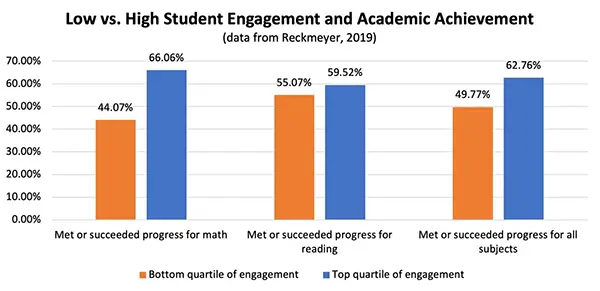- Creating a Positive Learning Environment
- Encouraging Active Learning and Collaboration
- Focusing on Student Comfort and Well-being
- Catering to Individual Learning Preferences
- Boosting Technology Inclusion
- Reducing Behavioral Issues and Distractions
- Promoting Ownership and Responsibility
- Adapting to Changing Educational Needs
Key Takeaway
- Outdated and uncomfortable furnishings may contribute to a lack of enthusiasm and focus among students while furnishing creates a positive and inviting atmosphere, making everyone feel comfortable and eager to participate.
- Cozy classroom furniture is significant for students’ physical health, which directly impacts their ability to concentrate and learn effectively, contributing to reducing behavioral issues and distractions.
- Schools are consistently integrating interactive whiteboards, tablets, and laptops into their educational approach. Classroom furniture must be versatile enough to accommodate the increasing use of technology.
Classroom furnishings play an imperative role in shaping the learning environment and directly impact student engagement and academic performance. Gone are the days of one-size-fits-all classroom setups with rows of fixed desks. Today, educators and researchers recognize the significance of creating flexible and dynamic studying spaces that cater to diverse student needs. In addition, high-impact ways to improve educational outcomes through technology also must be picked.
In this article, we will delve into the profound impact of schoolroom furnishings on student engagement and learning outcomes and explore how thoughtful design can transform traditional classrooms into thriving centers of active studying.

Creating a Positive Learning Environment
Classroom furnishings significantly influence the ambiance of the learning space. Bright, colorful, and ergonomic school furniture Canada can create a positive and inviting atmosphere, making students feel comfortable and eager to participate.
In contrast, outdated and uncomfortable furnishings may contribute to a lack of enthusiasm and focus among students. By investing in well-designed and aesthetically pleasing structures, schools can set the stage for a more enjoyable and productive learning experience.
Encouraging Active Learning and Collaboration
Traditional fixed desks can limit movement and restrict opportunities for collaboration. However, by introducing flexible seating arrangements such as tables with wheels, modular furniture, and bean bags, students have the freedom to move around and engage with their peers.
These flexible setups promote active learning, as students can work in small groups, discuss ideas, and actively participate in class discussions. Collaborative seating also fosters teamwork and communication skills, which are valuable for students’ personal and professional development. One of the flexible ways Google picked for students in Covid-19 was “Google new classroom tools for remote learning.”
Focusing on Student Comfort and Well-being
Having cozy classroom furniture is significant for students’ physical health, which directly impacts their ability to concentrate and learn effectively. Ergonomic chairs and adjustable desks contribute to maintaining good posture, lowering the chances of discomfort or musculoskeletal problems.
Comfy seating choices also help minimize distractions from discomfort, allowing students to focus more during classes and study periods.
Interesting Fact: There are various ways to measure student engagement such as surveys, checklists, rating scales, and much more. Technologies such as the “Audience Response System” can also help in these processes.
Catering to Individual Learning Preferences
Each student has a unique way of learning, and classroom furniture can be customized to support various studying preferences. For example, some students might like working at traditional desks for focused, independent tasks, while others excel in relaxed settings that encourage movement and teamwork.
Presenting a range of seating choices, like standing desks and lounge areas, empowers students to select what suits them best, ultimately improving their engagement and learning results.
Boosting Technology Inclusion
In our modern digital era, classroom furniture must be versatile enough to accommodate the increasing use of technology. Schools are consistently integrating interactive whiteboards, tablets, and laptops into their educational approach.
Consequently, classrooms must-have furniture that efficiently supports these devices. Furnishings that include built-in charging stations, cable management systems, and surfaces ideal for writing or typing are vital for seamlessly incorporating technology into the learning space.
Reducing Behavioral Issues and Distractions
Well-planned classroom furnishings can contribute to reducing behavioral issues and distractions. For example, placing seating strategically to minimize visual distractions and arranging students with diverse learning needs in appropriate spaces can enhance focus and minimize disruptive behaviors.
Moreover, organized and clutter-free classrooms provide students with an environment that promotes concentration and productivity.
Promoting Ownership and Responsibility
Allowing students to have input into classroom furnishings and design can foster a sense of ownership and responsibility for their learning environment. When students have a say in the setup and arrangement of the classroom, they are more likely to take pride in their space and treat it with respect. This sense of ownership can lead to a more engaged and invested student body.
Adapting to Changing Educational Needs
Classroom furnishings need to be flexible and adaptable to meet changing educational needs. As teaching methods and curricula evolve, the learning environment must be able to accommodate these shifts. Furniture that can be easily reconfigured and repurposed allows educators to adapt the classroom to suit different instructional approaches and cater to evolving student requirements.
Furnishings have a profound impact on student engagement and learning outcomes. Thoughtful and intentional design can create a positive and stimulating studying environment that fosters active learning, collaboration, and individualized instruction.
By investing in comfortable, flexible, and technology-friendly furnishings, schools can ensure dynamic spaces that empower students to reach their full potential. As educational institutions continue to prioritize student-centered approaches, classroom furnishings will remain a vital aspect of creating enriching and effective learning environments.







